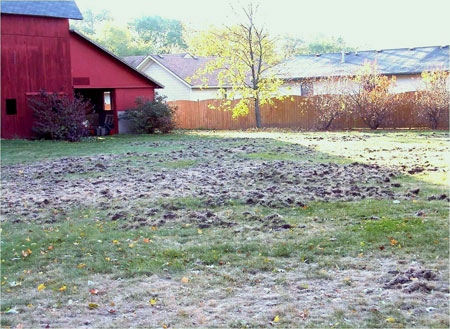Does a dormant lawn need to be treated for grubs?
Home lawns are the most susceptible to grub damage under dry conditions. If you have seen turf damage caused by grubs in the last two years, plan on applying an insecticide for grubs before August 1.
Michigan State University Extension offices are getting questions from homeowners about their lawns during this drought. One common question is “Do I still need to treat for grubs?”
Not everyone needs to treat their lawn for grubs. If you had an unacceptable amount of grub damage last year (2011) or the year before (2010) (Photo 1), you may want to apply an insecticide for grubs between now and August 1. This is the best time to treat your lawn for grubs because the insecticides work best on the young grubs, less than 0.5 inches long. Visit theturf.msu.edu website and scroll down the left side to “Home Lawn Grub Control Products” to see which products work the best. This is important because a few products sold for grub control at garden centers do not work at all on grubs.

Photo 1. Grub damage in a Michigan home lawn.
Most of the grub control products for homeowners come in a granular formulation that can be applied with a fertilizer spreader. If your lawn is now dormant and “crisp,” wait for a rain or water with 0.5 inches of irrigation before you apply the granular insecticide for grubs. Immediately after applying the insecticide, irrigate with an additional 0.5 inches of water. You can determine how much irrigation is applied or how much rain fell by placing several coffee cups in your lawn to act as a rain gauge. After the rain or irrigation, use a ruler to measure how deep the water is in the bottom of the coffee cups. You should continue irrigating until the coffee cups fill to a level of 0.5 inches above the bottom of the cup.
Protecting against grubs this year could be critical because drought-stressed turf does not have as large of a root system as healthy turf and, therefore, is more susceptible to grub feeding damage in late August, September and October. Even grub damage next April from European chafers could be more severe than usual in lawns weakened by drought.
Additional information
- MSU Extension’s Drought Resources
Dr. Smitley’s work is funded in part by MSU’s AgBioResearch.



 Print
Print Email
Email
